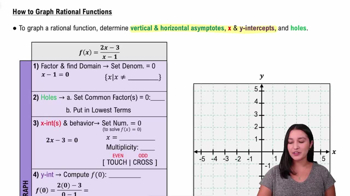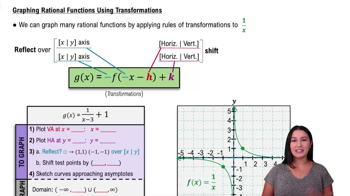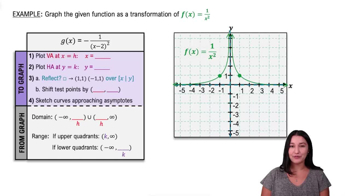Table of contents
- 0. Review of Algebra4h 16m
- 1. Equations & Inequalities3h 18m
- 2. Graphs of Equations43m
- 3. Functions2h 17m
- 4. Polynomial Functions1h 44m
- 5. Rational Functions1h 23m
- 6. Exponential & Logarithmic Functions2h 28m
- 7. Systems of Equations & Matrices4h 6m
- 8. Conic Sections2h 23m
- 9. Sequences, Series, & Induction1h 19m
- 10. Combinatorics & Probability1h 45m
5. Rational Functions
Graphing Rational Functions
Problem 60
Textbook Question
In Exercises 57–64, find the vertical asymptotes, if any, the horizontal asymptote, if one exists, and the slant asymptote, if there is one, of the graph of each rational function. Then graph the rational function. r(x) = (x^2 + 4x + 3)/(x + 2)^2
 Verified step by step guidance
Verified step by step guidance1
Identify the vertical asymptotes by setting the denominator equal to zero and solving for x: \((x + 2)^2 = 0\).
Determine the horizontal asymptote by comparing the degrees of the numerator and the denominator. Since the degree of the numerator \(x^2 + 4x + 3\) is 2 and the degree of the denominator \((x + 2)^2\) is also 2, the horizontal asymptote is \(y = \frac{a}{b}\), where \(a\) and \(b\) are the leading coefficients of the numerator and denominator, respectively.
Check for a slant asymptote. Since the degrees of the numerator and denominator are equal, there is no slant asymptote.
Summarize the asymptotes: Vertical asymptote at \(x = -2\), horizontal asymptote at \(y = 1\), and no slant asymptote.
Graph the rational function using the identified asymptotes and analyze the behavior of the function as it approaches these asymptotes.
Recommended similar problem, with video answer:
 Verified Solution
Verified SolutionThis video solution was recommended by our tutors as helpful for the problem above
Video duration:
10mPlay a video:
Was this helpful?
Key Concepts
Here are the essential concepts you must grasp in order to answer the question correctly.
Asymptotes
Asymptotes are lines that a graph approaches but never touches. Vertical asymptotes occur where a function is undefined, typically where the denominator equals zero. Horizontal asymptotes indicate the behavior of a function as x approaches infinity, while slant (or oblique) asymptotes occur when the degree of the numerator is one higher than that of the denominator, indicating a linear behavior at infinity.
Recommended video:

Introduction to Asymptotes
Rational Functions
A rational function is a function represented by the ratio of two polynomials. The general form is r(x) = P(x)/Q(x), where P and Q are polynomials. Understanding the degrees of the polynomials in the numerator and denominator is crucial for determining the behavior of the function, including the existence and type of asymptotes.
Recommended video:

Intro to Rational Functions
Graphing Rational Functions
Graphing rational functions involves analyzing their asymptotic behavior, intercepts, and overall shape. Key steps include identifying vertical and horizontal asymptotes, finding x- and y-intercepts, and determining the function's end behavior. This comprehensive approach helps in sketching an accurate graph that reflects the function's characteristics.
Recommended video:

How to Graph Rational Functions

 5:31m
5:31mWatch next
Master Graphing Rational Functions Using Transformations with a bite sized video explanation from Callie
Start learningRelated Videos
Related Practice



